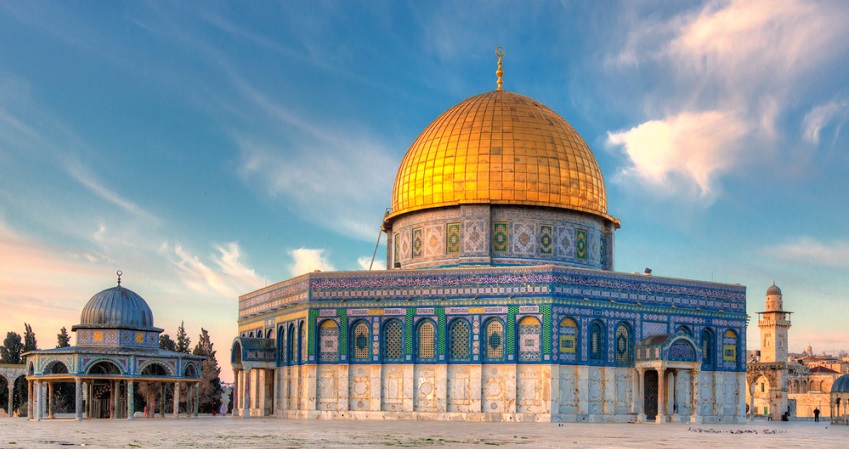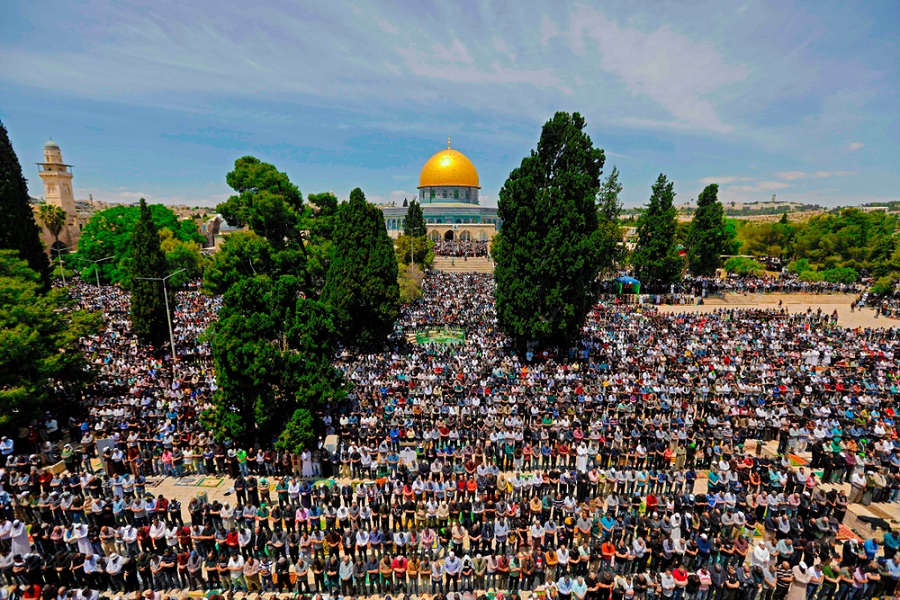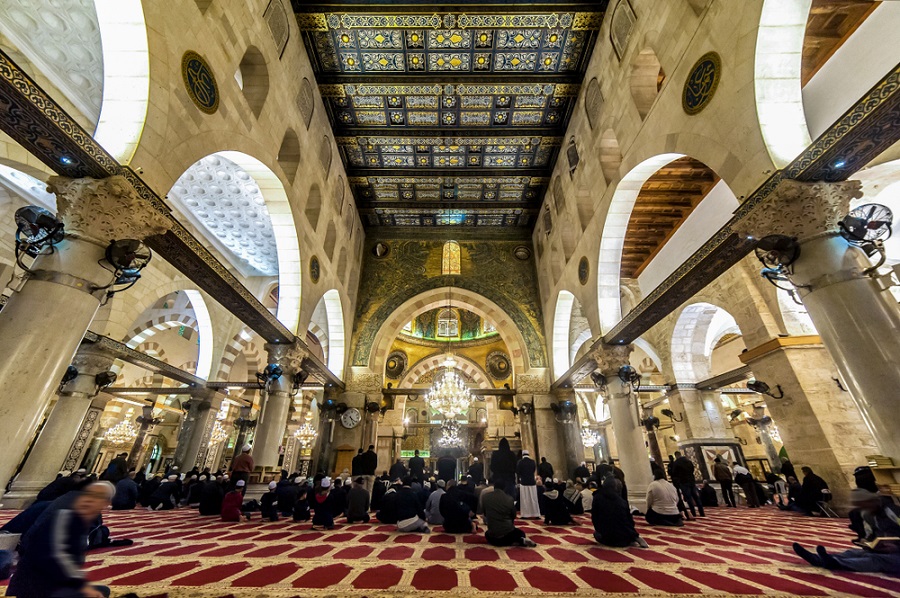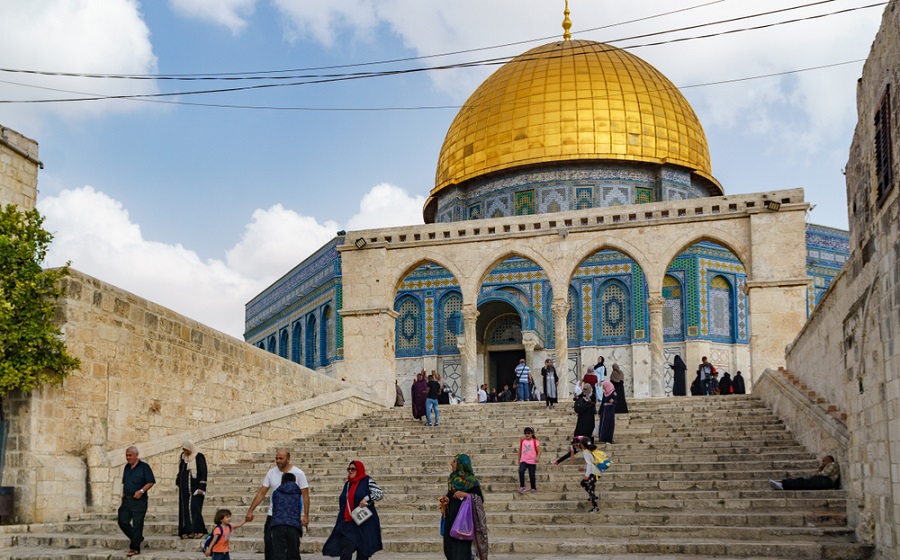Al-Aqsa Mosque, also known as the Farthest Mosque, is located in the old city of Jerusalem. It is considered the third holiest mosque in the world after the Al-Haram and the Al-Nabawi mosque. The history of Al-Aqsa makes it an important Muslim site. It is built over the Temple Mount, known as the Al –Aqsa compound or Haram esh-Sharif. This happened several years after the Prophet’s death. It is believed that the Prophet Muhammad (PBUH) traveled from the Great Mosque to the Al-Aqsa Mosque in the Night Journey on a ‘strange’ winged creature called Buraq in one night, after which he ascended to heaven where he met the rest of the Prophets and eventually God. History suggests that before The Prophet (PBUH) and the Muslims were ordered to pray towards the Kaaba, they directed their prayers towards this mosque. This is the reason why this mosque holds a special place in the hearts of Muslims.
Al-Aqsa Mosque History
The Mosque built on Temple Mount is known as Haram al-Sharif, this was expanded by King Herod the Great. Before this, in Islamic beliefs, the masjid is known to be dated to the time of Prophet Ibraham (PBUH). The Aqsa mosque was an important mosque during the lifetime of Prophet Ibrahim, his son Prophet Ishaq and grandson Prophet Yaqub(PBUH). When Prophet Yaqub’s son, Prophet Yusuf (PBUH) came into power, he suggested leaving Egypt where they were engulfed by poverty. Ever since there was no one to guard the Al-Aqsa mosque as their own and hence it expanded, renovated, and reconstructed many times. He trusted the people of Palestine, who were his believers to take care of the mosque.
The Israelites migrated to Egypt to look for better prospects of better material life. But these people fell into becoming slaves for the Egyptians until Prophet Musa (PBUH) or Moses was ordered by Allah to save them. However, they refused to return to Palestine on the orders of God and therefore were banished to wander around the desert for 40 years. This was the history of the Jews. Prophet Daoud (PBUH) started his kingdom in Palestine, and his son re-established the masjid with the help of the local people aside from which he also built a palace.
Importance and Story of Al-Aqsa Mosque
The masjid Al Aqsa Jerusalem played a very important role in the life of Prophet Muhammad (PBUH). The main reason for significance of Al Aqsa Mosque was that the masjid was home to many Prophets before Muhammad (PBUH) went there. It was the center of preaching monotheism. Later by order of Allah, the believers turned from facing the masjid to the holy Kaaba. A significant part of the history of Al Aqsa, which actually makes it an important mosque in Islam is the night of the journey or the night of Isra. During this journey, the Prophet fell asleep on the Kaaba, late at night. That is when the angel Jibreel provided him with a winged creature known as Burqa, who carried the Prophet(PBUH) to this mosque. Later that night, the Prophet (PBUH) departed his journey to Heaven.
Suggested Read: Isra Miraj: The Night Journey Of Prophet Muhammad (PBUH)
After the Prophet (PBUH) died, the second kalif of Islam, Umar Al Khattab entered Jerusalem without shedding any blood, when a Christian leader invited him. Umar’s personality resembled that of their liberator and thus, it wasn’t that difficult to accept him as their leader. Both Christians and Jews were happy to have him and the Muslims with their justice.
Al-Aqsa Mosque Architecture
The history of Al-Aqsa mentions some important architectural changes. The mosque is constructed upon an artificial platform supported by arches that were built to overcome difficult typographic conditions. The first renovation started in 1922. The renovations caused the establishment of the mosque’s ancient Umayyad foundations that changed the interior columns by the replacement of beams. These conserved the arches and drums in the interior of the main dome. The southern wall was also rebuilt and replaced timber with a slab of concrete.
However, earthquakes destroyed some of the renovations. And thus, finally, the architecture came down to:
- A rectangular mosque, that goes over for 36 acres and can accommodate 5000 worshipers.
- There is a Dome of Rock, which exhibits Byzantine architecture. Although nothing remains originally, the present-day dome is woodwork plated with enamelwork.
- Under the dome is a chapel or a Muslim prayer hall which is situated in the southern part of the masjid.
- The mosque also consists of a facade filled with balustrades consisting of arcades and small columns.
- The interior of the mosque features seven aisles with many halls. The mosaic and the inscriptions are facing the main entrance near the dome.
Al-Aqsa Mosque facts
- Masjid Al Aqsa is not just one mosque but a collection of mosques.
- The main mosque in the Al Aqsa complex is Qibla Mosque, present in the southern corner of the premises.
- Buraq Masjid and Marwani Mosque are also present in the Haram Al-Sharif or Al Aqsa Mosque.
- There are many graves of noble Muslims present in the complex, such as the grave of Prophet Suleiman.
- The name of the Masjid is mentioned in the holy book of the Quran along with the Holy Kaaba.
- Ihyaa Ulum Al-Din by Abu Hamid Al Ghazali, a famous Islamic literature book, was written inside Al Aqsa.
- The dome of the rock is among the initial domes built in Islam.
- Al Aqsa for long was used as dumping grounds by Romans until Hazrat Umar cleared the trash and litter from the premises.
An important part of the Islamic history, this mosque is a symbol of Allah’s greatness. It stands for a lot of things, and is an important Islamic religious site for Muslims around the world. A visit here is all one needs to witness the grandeur and the beauty of the Al Aqsa mosque.
FAQs about Al-Aqsa Mosque & Its History
What is the meaning of al-Aqsa?
Al-Aqsa means ‘the farthest mosque’ or the farthest sanctuary. It is called that because of the journey of the night of the Prophet (PBUH).
Why is al-Aqsa called ‘haram al sharif?
Al-Aqsa is also known as the Haram area which means the Nobel sanctuary which is so-called because of multiple reasons. The most important one being the travel of the Prophet (PBUH). Muhammad from the great mosque to Al-Aqsa followed by going to the path of heaven.
Why is Al-Aqsa mosque important?
The mosque is considered holy by the Muslims because not only it embarked on the journey of Prophet Muhammad (PBUH) to heaven, but also because the other Prophets before Muhammad prayed there and had major connections with the mosque.
Why is it called the Night Journey?
It is believed that The Prophet (PBUH) had his journey from the great mosque in Mecca to Jerusalem in a single night.
What is the ablution fountain?
The ablution fountain located in the northern part of the mosque is a place where Muslims perform their wudu or basically clean themselves before praying.
Who built Masjid Al Aqsa?
Prophet Ibrahim (PBUH) ordered to build Masjid Al Aqsa.











